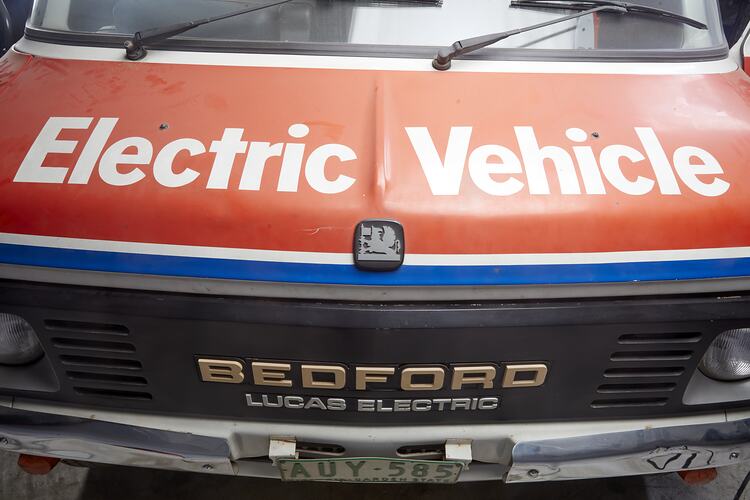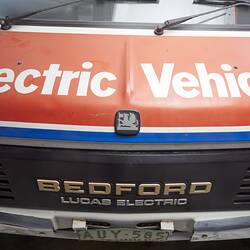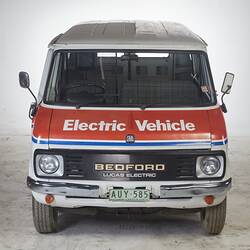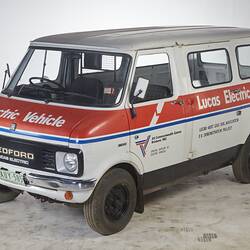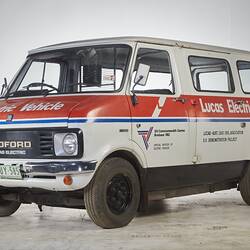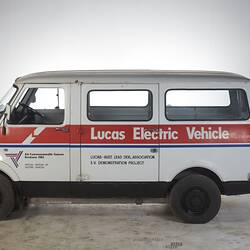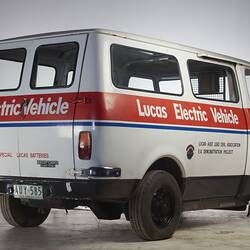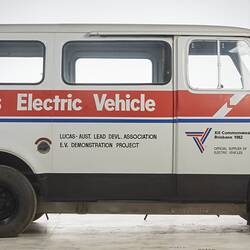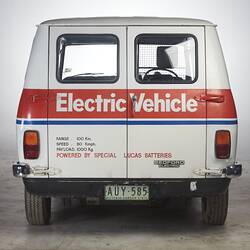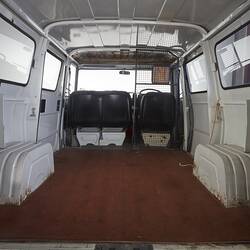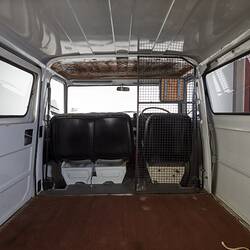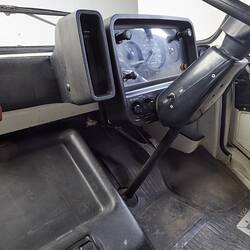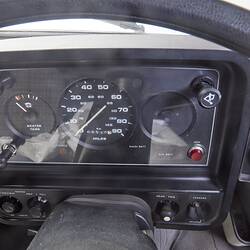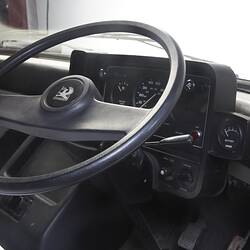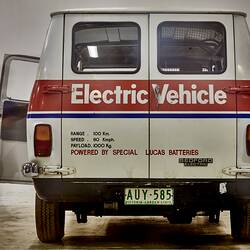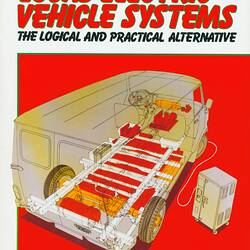Summary
Lucas Bedford electric van donated to the Museum by Lucas Industries Australia in 1984.The Museum's van is one of two such electric vans used during the 1982 Brisbane Commonwealth Games marathon. The other Lucas van is held by the Queensland Energy Museum.
The conversion of a petrol-engined Bedford van to electric power was first performed by Lucas Chloride EV Systems Limited in the UK in the late 1960s when a Bedford CA van was converted to electric power. In 1973-74 conversion of Bedford CF vans began and around 20 were built to be trialled by fleet operators in the UK. Development was apparently spurred by the oil crisis in the Middle East. About 200 such CFE vans were built and some were exported to the USA under the General Motors 'Griffon' brandname. Two of these modified UK-built Bedford CFE vans arrived in Australia in July 1981. Two earlier examples of this type of van had been imported previously in 1979-1980 for evaluation purposes. The two newer vans were sponsored by the Australian Lead Industry Development Association (ALDA) and were intended to be made available to a variety of government and private operators to carry out trials and therefore promote the Lucas Bedford CFE Van in real use conditions. The trial was based in Victoria where both vans were registered and the program was launched at Albert Park Lake in September 1981 after they had been tested, sign writing applied and side windows fitted.
The two ALDA sponsored vans were used as lead and follow-up vehicles for the marathon event during the 1982 Brisbane Commonwealth Games. The van had a range of 100 km, a top speed of 80 kph and a payload of 1000 kg. They were also used as official timing vehicles for the 1983 'City to Surf' marathon in Sydney and the 'Big M Melbourne Marathon'.
The Lucas Bedford Electric Van power system consists of a transversely mounted Lucas CAV 40kW electric motor driving the rear wheels via a two-stage reduction unit with regenerative braking. A 216 Volt battery pack is fitted under the floor of the cargo area consisting of 36 x 6 volt batteries. During the test program the vans were lent to various business and government operators for three to five weeks. The Museum's van was registered AUY585 and completed 5080 kilometres during the trial period which ended in October 1983. This included a month spent with Telecom as a line service vehicle in the Dandenong Ranges near Melbourne. It was driven by linesman Mr Mario Dietrantonio who recorded the van's performance for later evaluation by Lucas Industries. Like most earlier lead acid battery powered vehicles, the van was found to be heavy with a limited range. An electric version of the Bedford CF van was also built in Adelaide by Flinders University as part of their electric vehicle project in the 1970s.
Significance
The Lucas Bedford electric van is an example of a serious attempt by major automotive and electrical manufacturing firms to mass-produce an all-electric commercial vehicle in response to the early 1970s oil shock. There are earlier examples of electric and petrol-electric commercial vehicles built for specific tasks such as milk delivery but many of these designs were short-lived as internal combustion power came to dominate the market. The use of this van at major public events and in service trials with potential customers was intended to promote electric power using lead acid batteries but as the price of oil reduced after the mid-1970s oil crisis the operating cost advantages of electric power were harder to balance against the high purchase cost of electric vehicles. More recent environment driven developments in the search for alternative power and improvements in battery technology have seen renewed interest in all-electric or hybrid vehicles by large automotive manufacturers including General Motors.
More Information
-
Collecting Areas
-
Acquisition Information
Donation from Battery Division, Lucas Industries Australia Ltd, 03 Dec 1984
-
Manufacturer
-
User
Battery Division, Lucas Industries Australia Ltd, Australia, 1981-1984
-
Model Name or Number
-
Brand Names
-
Classification
-
Category
-
Discipline
-
Type of item
-
Overall Dimensions
4310 mm (Length), 1950 mm (Width), 1950 mm (Height), 3500 kg (Weight)
Weight includes 1000 kg battery pack.
-
References
-
Keywords
Commonwealth Games: Brisbane, 1982, Electric Vans, Electric Vehicles, Lead Acid Batteries
